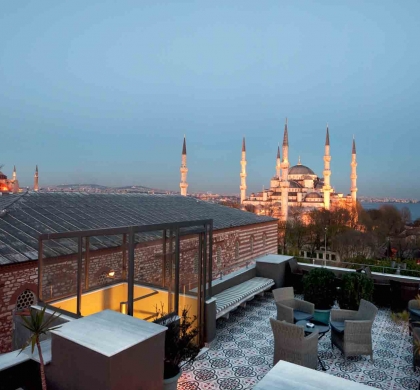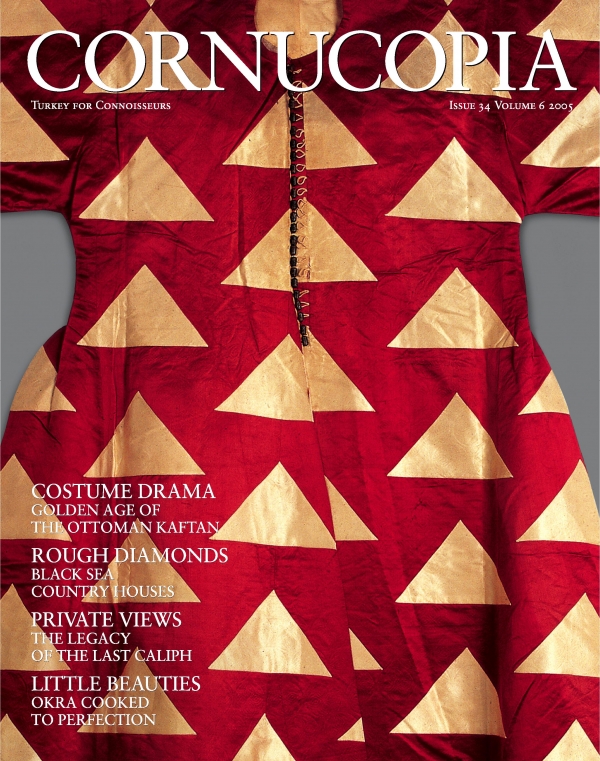Buy or gift a stand-alone digital subscription and get unlimited access to dozens of back issues for just £18.99 / $18.99 a year.
Please register at www.exacteditions.com/digital/cornucopia with your subscriber account number or contact subscriptions@cornucopia.net
Buy a digital subscription Go to the Digital EditionThe textiles in this article are from one of the most beautiful books ever written on the subject. Ipek, or Silk, now sadly out of print, had superb essays by Nurhan Atasoy, Julian Raby, Hülya Tezcan et al. William Morris and Mariano Fortuny familiarlised the West with the sumptuous floral designs of Ottoman textiles, but only connoisseurs were aware of the bolder side of Turkish design before its publication
WHAT THE BEST-DRESSED DIPLOMAT WAS WEARING…
Siegmund von Herberstein (1486–1566) served three Holy Roman Emperors as ambassador and was a keen observer of dress. His illustrated autobiography, published in 1560, shows him dressed in the robes he had worn in the presence of or had been given by the rulers of Poland, Russia and Spain as well as Turkey.
When Süleyman the Magnificent visited Buda in 1541, shortly after annexing most of Hungary, von Herberstein was representing the future Holy Roman Emperor, Ferdinand I, king of Bohemia and Hungary. He was dressed in a fashionable short Italian velvet gown with black stockings and shoes. These contrast strikingly with the robes of honour bestowed on him by the Sultan.
This disparity greatly amused his successor, the diplomat Ogier Ghiselin de Busbecq: “The Turks were quite as much astonished at our manner of dress as we at theirs. They wear long robes which reach almost to their ankles and are not only more imposing but seem to add to their stature; our dress, on the other hand, is so short and tight that it discloses the forms of the body, which would be better hidden, and is thus anything but becoming, and besides, for some reason or other, it takes away from a man’s height and gives him a stunted appearance.” Von Herberstein’s new robes are so accurately rendered that the draughtsman even shows the different heights of pile. The inner kaftan is of Turkish velvet, and the outer, ceremonial kaftan is made of two types of Italian velvet, which was considered second only to cloth of gold and silver in luxury and prestige.
Elsewhere Busbecq spoke of Turkish silks in rhapsodic fashion: “Now come with me and cast your eye over the immense crowd of turbaned heads, wrapped in countless folds of the whitest silk, and bright raiment of every kind and hue, and everywhere the brilliance of gold, silver, purple, silk and satinÉ A more beautiful spectacle was never presented to my gaze.” In the early eighteenth century Lady Mary Wortley Montagu, the great wit and letter writer who was wife of the English ambassador, was transported by the vision of a beautifully dressed Turkish woman of Edirne: “She was dress’d in a Caftan of Gold brocade flower’d with Silver, her drawers were pale pink, Green and silver, her Slippers white. On her Head a rich Turkish Handkerchief of pink and Silver. I have read somewhere that Women allways speak in rapture when they speak of Beauty, but I can’t imagine why they should not be allow’d to do so.” These and many other documents attest to the fascination exercised upon the European mind by Turkish silks. Later, in the nineteenth and twentieth centuries, European designers from William Morris to Mariano Fortuny brought their admiration for Turkish silks into the mainstream of European textile design, while the great European and American collections of applied arts acquired Turkish silks in vast numbers.
Busbecq’s eloquent description of the role of textiles in expressing imperial splendour, and thus imperial power, goes to the core of how Ottoman woven silk fabrics impressed Turks and foreigners alike. Turkish silks reflected the ideology of power, and facilitated the projection of that power in the empire and beyond. Because of their role as diplomatic gifts, they came to symbolise the Ottoman imperium to foreigners, while within the huge empire they were a major form of artistic expression, an important vehicle for the transmission of artistic ideas, and a key factor in the economy. Silks played an important role in Ottoman public ceremonies and in upper-class culture. State officials could expect to be rewarded for their efforts in silk, such was the status it denoted.
Crescent and Rose (also published under the title Ipek (Silk), a superbly produced book by Nurhan Atasoy, Walter B Denny, Louise W Mackie and Hülya Tezcan, published by the Türk Ekonomi Bankası (TEB) is now, unfortunately, out of print.
Also see Rapt in Silk: the backstory
A new book on Vassilaki Kargopoulo: Photographer to His Majesty the Sultan. By Philip Mansel
Dedicated to Venus by the Romans, no other fruit has so many symbolic and material associations with sensual beauty. Lovely soft pink flowers are followed by crimson velvetly fruit, soft and round, with a heavenly taste and aroma.
More cookery features
The intoxicating scent of attar of roses, the oil distilled from the petals of damask roses, has worked its magic on men and women for centuries. Martyn Rix traces the history of the damask rose from its roots in Neolithic times and travels to Isparta in southwest Anatolia to see how these precious petals yield up a liquid worth its weight in gold
Few travellers to Turkey enjoying the hedonistic delights of Mediterranean cruising venture east of Antalya, capital of Anatolia’s Turquoise Coast – intimidated perhaps by rumours of a wild hinterland that even Alexander the Great found hard to tame. But those who dare to leave the crowds behind will discover an awe-inspiring landscape of cliffs that drop sheer to the sea, epic castles and remote Byzantine retreats. Kate Clow and Jacqueline de Gier joined ten other guests and a lecturer for a twelve-day voyage of enlightenment aboard a traditional gulet
Geoffrey Lewis, acknowledged as the dean of Turkish studies in Britain and beyond, learned the language while serving in the RAF in Egypt. When he finally visited Turkey, he was smitten for good. By Andrew Mango. Portrait by Charles Hopkinson
For more than thirty years Terence Mitford and George Bean painstakingly identified and recorded the forgotten ancient sites of Turkey’s Aegean and southern shores. Their contribution to the preservation of the country’s archaeological heritage is incalculable, their guidebooks are legendary, yet the men themselves are unsung. Barnaby Rogerson, in this homage to his heroes, uncovers an extraordinary pair: a gentle giant and a man of steel
The dusty rooms of a crumbling Istanbul palazzo are a living museum of the plaster-caster’s art. Berrin Torolsan visits the heir to a fine tradition. Photographs by Fritz von der Schuelnburg




Bezmärä Ensemble

The Emirğan Ensemble




Cornucopia works in partnership with the digital publishing platform Exact Editions to offer individual and institutional subscribers unlimited access to a searchable archive of fascinating back issues and every newly published issue. The digital edition of Cornucopia is available cross-platform on web, iOS and Android and offers a comprehensive search function, allowing the title’s cultural content to be delved into at the touch of a button.
Digital Subscription: £18.99 / $18.99 (1 year)
Subscribe now